Analys
Trade war and Nopec-shake, but market looks like tightening

 Brent crude sold off 1.7% yesterday with a close of $61.63/bl but has rebounded 0.4% today trading at $61.8/bl. The sell-off came on the back of a 0.9% decline in S&P 500 and a marginally stronger dollar with DXY now just 0.9% below the highs from late 2018. The clear driver for the sell-off in both crude and equities was the signal from Donald Trump that there will be no trade deal between China and the US before the March 1 deadline runs out. The consequence of this is that tariffs on about $200bn worth of goods from China will increase from 10% to 25% from March 1. It definitely took the air out of growth hopes both for economics and for oil.
Brent crude sold off 1.7% yesterday with a close of $61.63/bl but has rebounded 0.4% today trading at $61.8/bl. The sell-off came on the back of a 0.9% decline in S&P 500 and a marginally stronger dollar with DXY now just 0.9% below the highs from late 2018. The clear driver for the sell-off in both crude and equities was the signal from Donald Trump that there will be no trade deal between China and the US before the March 1 deadline runs out. The consequence of this is that tariffs on about $200bn worth of goods from China will increase from 10% to 25% from March 1. It definitely took the air out of growth hopes both for economics and for oil.
US Nopec legislation (“No Oil Producing and Exporting Cartels Act 2019”) moved forward in the US. The bill was approved by the House judiciary committee on Thursday and is now ready for a full House vote. It will also need to be approved by the US Senate. Given Donald Trump’s known hostile stance towards OPEC it now looks like a very good chance that the bill will actually be voted through without being vetoed down by the President (George W Bush did that last time the bill was promoted). The prospect of a passage of Nopec legislation has added bearish pressure to Brent crude.
We don’t think that OPEC intervention matters all that much in the medium to longer term. After all, it is not low cost OPEC oil which sets the marginal cost of oil in the global market. It is the higher non-OPEC marginal cost which sets the global oil price over time. OPEC can never escape from this fact.
OPEC intervention is however a very important short term oil price driver. It is no doubt that the boost in production by OPEC+ from May to November last year helped to drown the global market in oil and crash the oil price from October to December. It is likewise just as clear that the revival in oil prices since December low of just below $50/bl to a recent high of $63.63/bl has the fingerprint of production cuts agreed by OPEC+ in December all over it.
So if the US Nopec legislation is voted through and becomes law it could definitely be bearish for oil prices right here and now given that OPEC+ is in the midst of tactical production cuts right this moment. The Nopec law will enable the US to prosecute OPEC members for price manipulation and potentially confiscate oil assets in the US belonging to such OPEC members. Whether OPEC members in general and Saudi Arabia specifically would cave in if Nopec becomes law remains to be seen. Qatar however left OPEC in December after 57 years in the group presumably due to the risk of Nopec becoming law.
It is Saudi Arabia which really is the captain of the OPEC ship. It is also Saudi Arabia who really moves supply up and down and moves the market with the other members just pitching in a little. The Nopec legislation could end tactical, cooperative production cuts and increases orchestrated by OPEC. It should probably not hinder Saudi Arabia to move production up and down on its own in order to address tactical turns and imbalances in the global oil market.
The Nopec legislation is however right in the face of Saudi Arabia. If Nopec becomes law it must be very damaging to the long lasting relationship between the US and Saudi Arabia. How can they go on being best palls if the US kills off OPEC as an organisation we wonder? This may be the next step in the geopolitical changes taking place in the Middle East. The US needs the Middle East less due to close to self-sufficiency of oil. China and India needs it more and more along with their rapidly rising oil imports and Russia is eager to get closer ties and influence in the region. Thus geopolitical changes could be the biggest fall-out.
OPEC’s true value strategy is not primarily about holding back supply tactically from existing production capacity from time to time even though this is primarily what the oil market is focusing on. The true strategy for OPEC is to make sure that they do not over-invest in their own low cost oil assets over time. It is about making sure that the global oil price balances on the higher non-OPEC marginal cost and not through over-investments within OPEC ends up balancing on low cost OPEC oil.
Thus OPEC needs to make sure that if global oil demand grows with some 1.4 m bl/d per year, then production growth from OPEC should be materially less than that. Achieving that is not about holding back production in existing capacity. It is about making sure that upstream investments in OPEC are not too high. The true OPEC strategy is thus about investment discipline over time and not about production discipline from existing capacity. On this more strategic issue it is not so clear that Nopec legislation will have all that much impact.
The amount of fossil fuels in the world is in a human perspective more or less infinite. It is all over the place. We are not running out. The price of oil is about how much oil we have above ground and not about how much is in the ground. Thus discipline on investments is OPEC’s true strategy.
As of right now OPEC+ continues to firm up the global market with its tactical tightening agreed upon in December. In addition we are losing volumes in Venezuela and Iran while general Haftar is fighting over the Sharara oil field in Libya.
Our view is that the situation in Venezuela will get worse before it gets better. US sanctions are biting and a visible reflection of that could be the softer shipping rates for Caribbean to the US Gulf trades since early January. I.e. it looks like shipments of oil out of Venezuela are declining further due to US sanctions. There may be a regime shift from Maduro to Guaido sometime in the future but we find it hard to imagine that Maduro will give up easily as he is backed by China and Russia. Even after a potential shift it will take time to revive confidence to international investors (debt holders) and oil service companies as well as all the oil service personnel which has fled the country. Money, people, competence and companies needs to move back to the country and then the oil industry needs to be revived. It is hard to see a strong revival in oil production in Venezuela this year.
Iran is definitely a sad, sad story and US shale oil production boom is bad, bad news for the Iran. Donald Trump handed out handsome oil import waivers to international buyers in Q4-18 in order to avoid a spike in the oil price. However, every additional barrel of oil produced in the US enables the US to reduce the Iran waivers just as much. Thus the more you are bullish US crude production, the more you should expect to see further declines in Iran oil exports along with smaller and smaller US waivers being handed out. Thus more US oil probably means comparably less oil out of Iran. Unfortunately for Iran.
The global economy is of great concern with continued US-China trade war (no resolution by March 1) and weakening outlook in general driving the outlook for global oil demand growth in 2019 lower. Global refining margins have moved down to very weak and painful levels at which refineries becomes increasingly likely to reduce their refining utilization. We are also moving towards the spring (March, April) refinery turnarounds where refineries are taken off-line for maintenance and summer tuning. This should lead to a temporary softer crude market with somewhat weaker crude spot dynamics over the next couple of months which might weight bearishly on crude prices. I.e. crude prices could be more bearishly sensitive to ingredients like a stronger dollar and/or equity sell-offs.
In total and on balance, it still looks like the crude oil market is on a tightening path due to both voluntary and involuntary cuts by OPEC+. Set-backs in the oil price rally since late December is however clearly a risk with Nopec, US-China trade war, global growth concerns, weak refinery margins, US dollar strength and potential sell-offs in the S&P 500 as the main concerns.
Analys
OPEC+ will likely unwind 500 kb/d of voluntary quotas in October. But a full unwind of 1.5 mb/d in one go could be in the cards

Down to mid-60ies as Iraq lifts production while Saudi may be tired of voluntary cut frugality. The Brent December contract dropped 1.6% yesterday to USD 66.03/b. This morning it is down another 0.3% to USD 65.8/b. The drop in the price came on the back of the combined news that Iraq has resumed 190 kb/d of production in Kurdistan with exports through Turkey while OPEC+ delegates send signals that the group will unwind the remaining 1.65 mb/d (less the 137 kb/d in October) of voluntary cuts at a pace of 500 kb/d per month pace.

Signals of accelerated unwind and Iraqi increase may be connected. Russia, Kazakhstan and Iraq were main offenders versus the voluntary quotas they had agreed to follow. Russia had a production ’debt’ (cumulative overproduction versus quota) of close to 90 mb in March this year while Kazakhstan had a ’debt’ of about 60 mb and the same for Iraq. This apparently made Saudi Arabia angry this spring. Why should Saudi Arabia hold back if the other voluntary cutters were just freeriding? Thus the sudden rapid unwinding of voluntary cuts. That is at least one angle of explanations for the accelerated unwinding.
If the offenders with production debts then refrained from lifting production as the voluntary cuts were rapidly unwinded, then they could ’pay back’ their ’debts’ as they would under-produce versus the new and steadily higher quotas.
Forget about Kazakhstan. Its production was just too far above the quotas with no hope that the country would hold back production due to cross-ownership of oil assets by international oil companies. But Russia and Iraq should be able to do it.
Iraqi cumulative overproduction versus quotas could reach 85-90 mb in October. Iraq has however steadily continued to overproduce by 3-5 mb per month. In July its new and gradually higher quota came close to equal with a cumulative overproduction of only 0.6 mb that month. In August again however its production had an overshoot of 100 kb/d or 3.1 mb for the month. Its cumulative production debt had then risen to close to 80 mb. We don’t know for September yet. But looking at October we now know that its production will likely average close to 4.5 mb/d due to the revival of 190 kb/d of production in Kurdistan. Its quota however will only be 4.24 mb/d. Its overproduction in October will thus likely be around 250 kb/d above its quota with its production debt rising another 7-8 mb to a total of close to 90 mb.
Again, why should Saudi Arabia be frugal while Iraq is freeriding. Better to get rid of the voluntary quotas as quickly as possible and then start all over with clean sheets.
Unwinding the remaining 1.513 mb/d in one go in October? If OPEC+ unwinds the remaining 1.513 mb/d of voluntary cuts in one big go in October, then Iraq’s quota will be around 4.4 mb/d for October versus its likely production of close to 4.5 mb/d for the coming month..
OPEC+ should thus unwind the remaining 1.513 mb/d (1.65 – 0.137 mb/d) in one go for October in order for the quota of Iraq to be able to keep track with Iraq’s actual production increase.
October 5 will show how it plays out. But a quota unwind of at least 500 kb/d for Oct seems likely. An overall increase of at least 500 kb/d in the voluntary quota for October looks likely. But it could be the whole 1.513 mb/d in one go. If the increase in the quota is ’only’ 500 kb/d then Iraqi cumulative production will still rise by 5.7 mb to a total of 85 mb in October.
Iraqi production debt versus quotas will likely rise by 5.7 mb in October if OPEC+ only lifts the overall quota by 500 kb/d in October. Here assuming historical production debt did not rise in September. That Iraq lifts its production by 190 kb/d in October to 4.47 mb/d (August level + 190 kb/d) and that OPEC+ unwinds 500 kb/d of the remining quotas in October when they decide on this on 5 October.

Analys
Modest draws, flat demand, and diesel back in focus

U.S. commercial crude inventories posted a marginal draw last week, falling by 0.6 million barrels to 414.8 million barrels. Inventories remain 4% below the five-year seasonal average, but the draw is far smaller than last week’s massive 9.3-million-barrel decline. Higher crude imports (+803,000 bl d WoW) and steady refinery runs (93% utilization) helped keep the crude balance relatively neutral.

Yet another drawdown indicates commercial crude inventories continue to trend below the 2015–2022 seasonal norm (~440 million barrels), though at 414.8 million barrels, levels are now almost exactly in line with both the 2023 and 2024 trajectory, suggesting stable YoY conditions (see page 3 attached).
Gasoline inventories dropped by 1.1 million barrels and are now 2% below the five-year average. The decline was broad-based, with both finished gasoline and blending components falling, indicating lower output and resilient end-user demand as we enter the shoulder season post-summer (see page 6 attached).
On the diesel side, distillate inventories declined by 1.7 million barrels, snapping a two-week streak of strong builds. At 125 million barrels, diesel inventories are once again 8% below the five-year average and trending near the low end of the historical range.
In total, commercial petroleum inventories (excl. SPR) slipped by 0.5 million barrels on the week to ish 1,281.5 million barrels. While essentially flat, this ends a two-week streak of meaningful builds, reflecting a return to a slightly tighter situation.
On the demand side, the DOE’s ‘products supplied’ metric (see page 6 attached), a proxy for implied consumption, softened slightly. Total demand for crude oil over the past four weeks averaged 20.5 million barrels per day, up just 0.9% YoY.
Summing up: This week’s report shows a re-tightening in diesel supply and modest draws across the board, while demand growth is beginning to flatten. Inventories remain structurally low, but the tone is less bullish than in recent weeks.
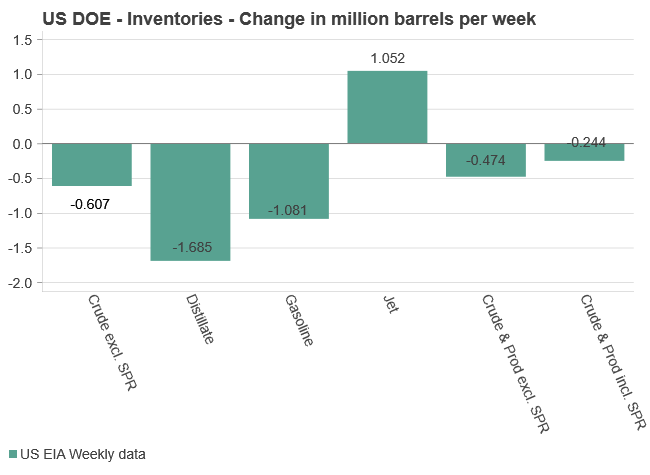
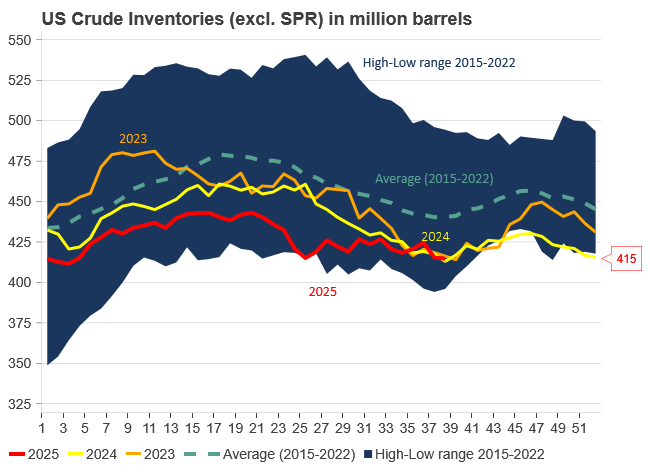
Analys
Are Ukraine’s attacks on Russian energy infrastructure working?

Brent crude rose 1.6% yesterday. After trading in a range of USD 66.1 – 68.09/b it settled at USD 67.63/b. A level which we are well accustomed to see Brent crude flipping around since late August. This morning it is trading 0.5% higher at USD 68/b. The market was expecting an increase of 230 kb/d in Iraqi crude exports from Kurdistan through Turkey to the Cheyhan port but that has so far failed to materialize. This probably helped to drive Brent crude higher yesterday. Indications last evening that US crude oil inventories likely fell 3.8 mb last week (indicative numbers by API) probably also added some strength to Brent crude late in the session. The market continues to await the much heralded global surplus materializing as rising crude and product inventories in OECD countries in general and the US specifically.

The oil market is starting to focus increasingly on the successful Ukrainian attacks on Russian oil infrastructure. Especially the attacks on Russian refineries. Refineries are highly complex and much harder to repair than simple crude oil facilities like export pipelines, ports and hubs. It can take months and months to repair complex refineries. It is thus mainly Russian oil products which will be hurt by this. First oil product exports will go down, thereafter Russia will have to ration oil product consumption domestically. Russian crude exports may not be hurt as much. Its crude exports could actually go up as its capacity to process crude goes down. SEB’s Emerging Market strategist Erik Meyersson wrote about the Ukrainian campaign this morning: ”Are Ukraine’s attacks on Russian energy infrastructure working?”. Phillips P O’Brian published an interesting not on this as well yesterday: ”An Update On The Ukrainian Campaign Against Russian Refineries”. It is a pay-for article, but it is well worth reading. Amongst other things it highlights the strategic focus of Ukraine towards Russia’s energy infrastructure. A Ukrainian on the matter also put out a visual representation of the attacks on twitter. We have not verified the data representation. It needs to be interpreted with caution in terms of magnitude of impact and current outage.
Complex Russian oil refineries are sitting ducks in the new, modern long-range drone war. Ukraine is building a range of new weapons as well according to O’Brian. The problem with attacks on Russian refineries is thus on the rise. This will likely be an escalating problem for Russia. And oil products around the world may rise versus the crude oil price while the crude oil price itself may not rise all that much due to this.
Russian clean oil product exports as presented by SEB’s Erik Meyersson in his note this morning.
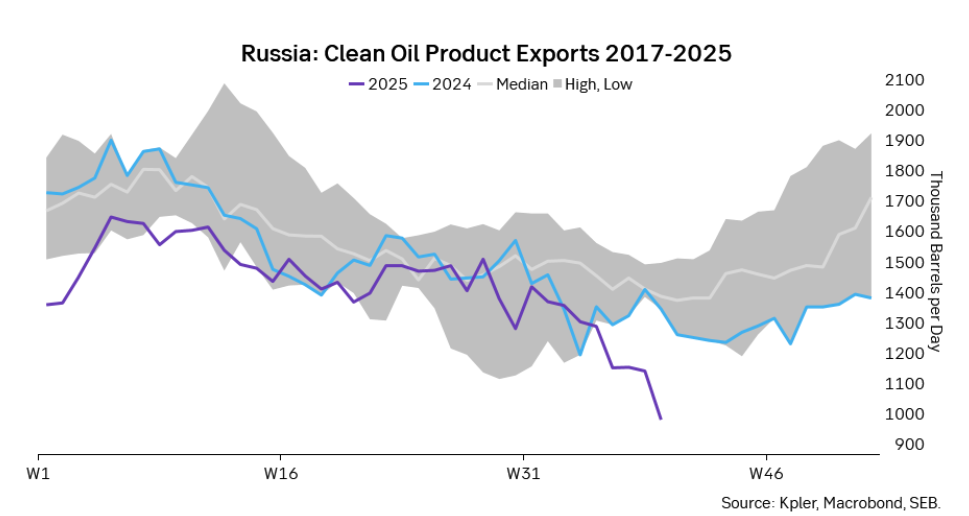
The ICE Gasoil crack and the 3.5% fuel oil crack has been strengthening. The 3.5% crack should have weakened along with rising exports of sour crude from OPEC+, but it hasn’t. Rather it has moved higher instead. The higher cracks could in part be due to the Ukrainian attacks on Russian oil refineries.
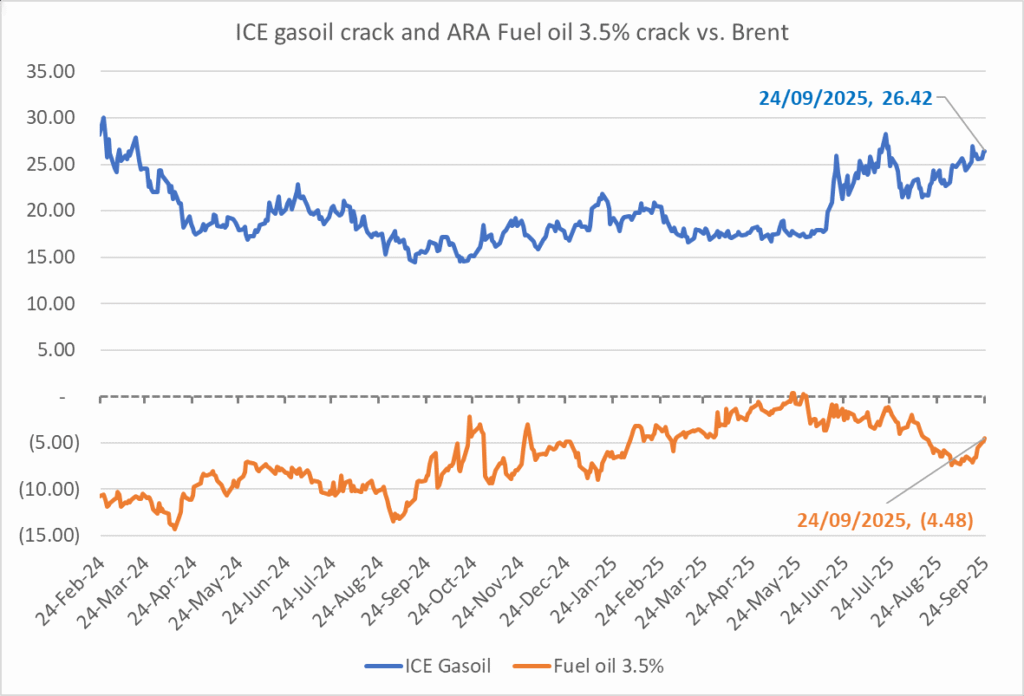
Ukrainian inhabitants graphical representation of Ukrainian attacks on Russian oil refineries on Twitter. Highlighting date of attacks, size of refineries and distance from Ukraine. We have not verified the detailed information. And you cannot derive the amount of outage as a consequence of this.

-
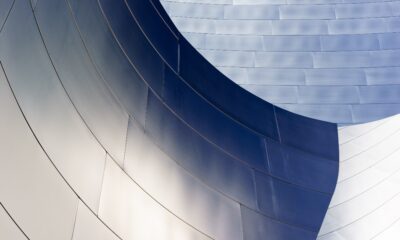
 Nyheter4 veckor sedan
Nyheter4 veckor sedanEurobattery Minerals satsar på kritiska metaller för Europas självförsörjning
-

 Nyheter3 veckor sedan
Nyheter3 veckor sedanMahvie Minerals i en guldtrend
-

 Nyheter4 veckor sedan
Nyheter4 veckor sedanGuldpriset kan närma sig 5000 USD om centralbankens oberoende skadas
-

 Nyheter4 veckor sedan
Nyheter4 veckor sedanOPEC signalerar att de inte bryr sig om oljepriset faller kommande månader
-

 Analys3 veckor sedan
Analys3 veckor sedanVolatile but going nowhere. Brent crude circles USD 66 as market weighs surplus vs risk
-

 Nyheter3 veckor sedan
Nyheter3 veckor sedanAktier i guldbolag laggar priset på guld
-

 Nyheter3 veckor sedan
Nyheter3 veckor sedanKinas elproduktion slog nytt rekord i augusti, vilket även kolkraft gjorde
-

 Nyheter2 veckor sedan
Nyheter2 veckor sedanTyskland har så höga elpriser att företag inte har råd att använda elektricitet








